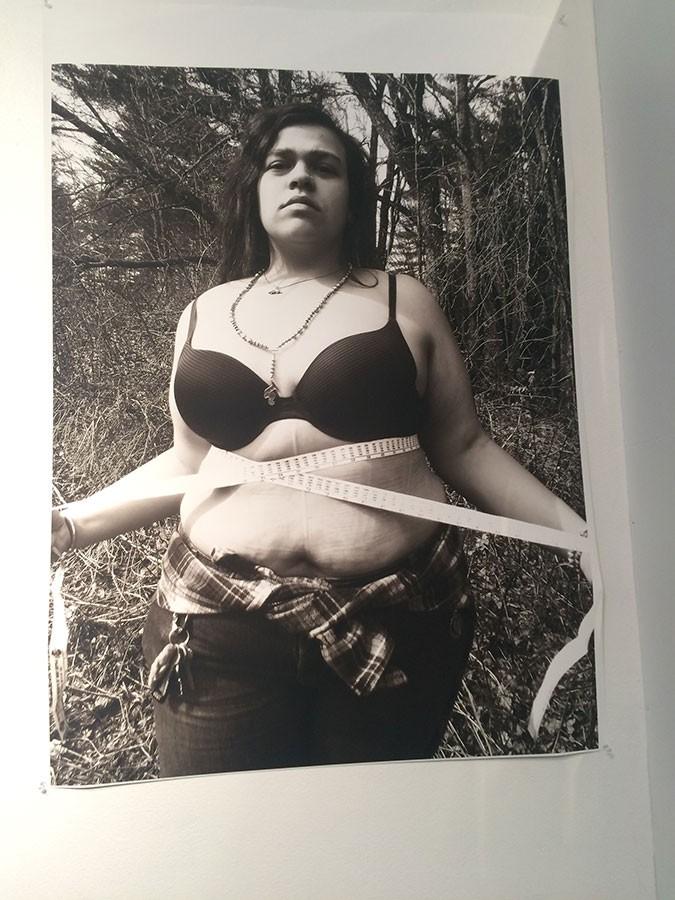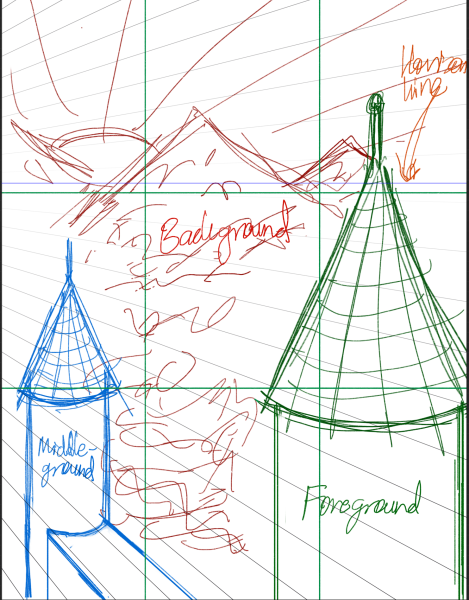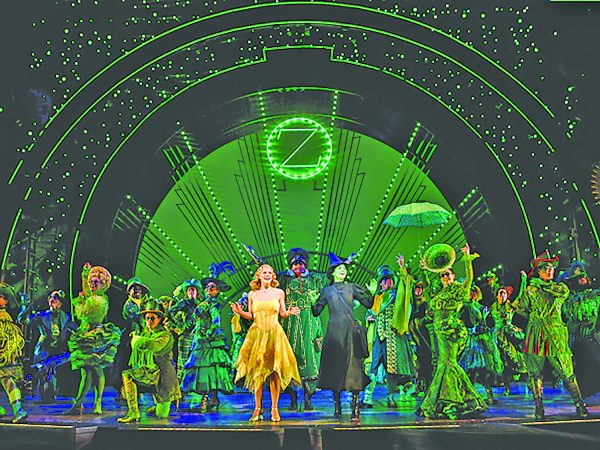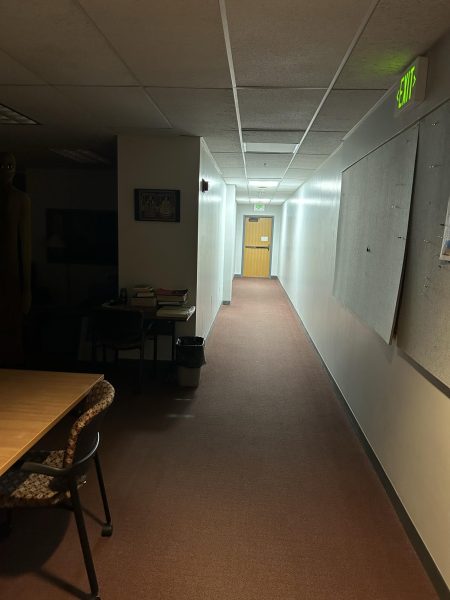BFA students present evocative exhibit
Mina Ganguly-Kiefner, Kim Anetsburger, Dylan Dalmata, and Randa Morris gathered in the Julian Scott Memorial gallery to present their BFA theses surrounding the themes off body positivity, self-worth, and acceptance on April 14.
After light refreshments, Michael Zebrowski, assistant professor of studio arts and director of the Julian Scott Memorial gallery, jumped up and announced that the show would start by hearing from Ganguly-Kiefner and then work clock-wise around the gallery.
Ganguly-Kiefner started her exhibition with a spoken word performance of her artist statement, which is a poem. She went on in the poem to talk about her skin color, her weight, and personal strengths like kindness and fear. Concluding the poem, she said, “I need more. I just need more. I need more body,” which showcased the title of her show, “I Need More Body.”
Ganguly-Kiefner’s show took up one wall and was divided into three components: sculpture, poem, and print. Her portion of the space started with the huge printed poem next to a print of Ganguly-Kiefner constricting herself with measuring tape, which was a profound image. Next were shattered shards of mirror that had printed images on them and were skillfully attached to the wall. Between those walls was a podium with two handmade dolls holding on to each other as they were “sliding” off of the podium, about to fall to their doom in a box full of other discarded dolls.
The other section of the wall was covered in body positive sticky notes saying things like “You don’t need to change” and “You are not unworthy,” in addition to prints that were black and white as well as water-colored. A bed was against that wall, covered in a hand-made quilt. In the corner were other dolls and stuffed animals Ganguly-Kiefner had made and collected, symbolizing her journey of self-love.
Her doll-making and sewing skills were self-taught, and it can take her anywhere from two weeks to two months to make a piece. “I got into doll making because of my love of movement,” said Ganguly-Kiefner. “I owned a porcelain doll named Elizabeth and after a house fire she was the only thing that was really ‘mine.’”
“I truly love all of my pieces, but I love my mirror shards and artist statement most because it is poetry, and the mirror shards create kinetic art as people move along the shards,” said Ganguly-Kiefner. “It conveys a message about how we all pick apart ourselves as our parts are exposed in the reflection of the mirror.”
To parallel, on the next wall, was an interactive piece by Dylan Dalmata. A big flat-screen TV was set up with a looping video of him and others skiing and snowboarding, as well as playing in bands and going to shows. Two very different but similar activities were titled, “Rad Habits.” Attached to the TV was a snowboard that you could hop up onto, and the music and video clip would change.
“This is an embodiment of the shred, sex, and rock and roll lifestyle that me and my friends live,” Dalmata said. “It is not just about going up and doing some sport on the mountain. Some people think it is inappropriate and immature, but it is just what we do.”
Dalmata’s video glimpse of his day-to-day lifestyle was vastly different than the scrutiny and shame Ganguly-Kiefner feels, although the video was crafted elegantly to portray the art in music and athletics. The different video clips portray Dalmata traveling, performing, and going to outdoor tournaments.
On the next wall was another heavy topic focusing on gender with artwork from Randa Morris. “My work focuses on body image and how you see yourself versus how the world sees you,” said Morris.
Morris’ artwork was very cartoon-like, and each piece was a different person that was hand-drawn and hanging from a nail over the underlying image. Some were personal and seemed to be self-portraits, where other pieces were more geared toward the everyday person. One piece, which sparked a lot of curiosity, was of a hanging person with a stomach full of eyeballs, hanging over a crowd of zombie-like people.
“I am not really sure about what to say about my work because, for me, it speaks for itself. It is a personal piece, and I like to view it how they would view it and not have to put any ideas into their heads,” Morris said.
Unfortunately, because of technical difficulties, Morris was unable to digitally create the backgrounds for her characters to hang over.
All artists specialized in different mediums, and Kim Anetsburger was the painter of the four. Her paintings were on the left hand side of the gallery, with her huge self-portrait statement piece in the middle. “Blunt Perspective” is a series of five paintings done from her perspective, looking down at her own body.
Anestburger is known for painting cheeky things, usually containing nudity, but these five were more serious and intuitive for the viewer. “Basically the reason I do this is because I have always had an odd curiosity about what people would think if they were me. My mom would always say things like, ‘You don’t know what they are going through,’ and I always catch myself thinking . . . ‘What are their problems?’” said Anetsburger.
Anetsburger often thinks about the possibility of someone else leading her life, and she will make rules of what they can and can’t “see.”
“I began to realize I would feel really uncomfortable if someone was watching my day-to-day life, but I would actually feel least uncomfortable if someone saw my body and that is why I chose to paint it,” said Anetsburger.
With these thoughts in mind, Anetsburger wanted to show what it would be like for someone else to be her at that very moment. These paintings evoke a sense of nervousness, loneliness, and comfortability that is true to her personality. “I often go between not caring at all about how I act to worrying if I am messing everything up,” said Anetsburger.
Zebrowski ended by saying it was an amazing collaborative effort with the four BFA’s in sharing space and making presentation appear effortless. Although these four students worked in vastly different mediums and styles, they all beautifully evoked the same themes through their art.






